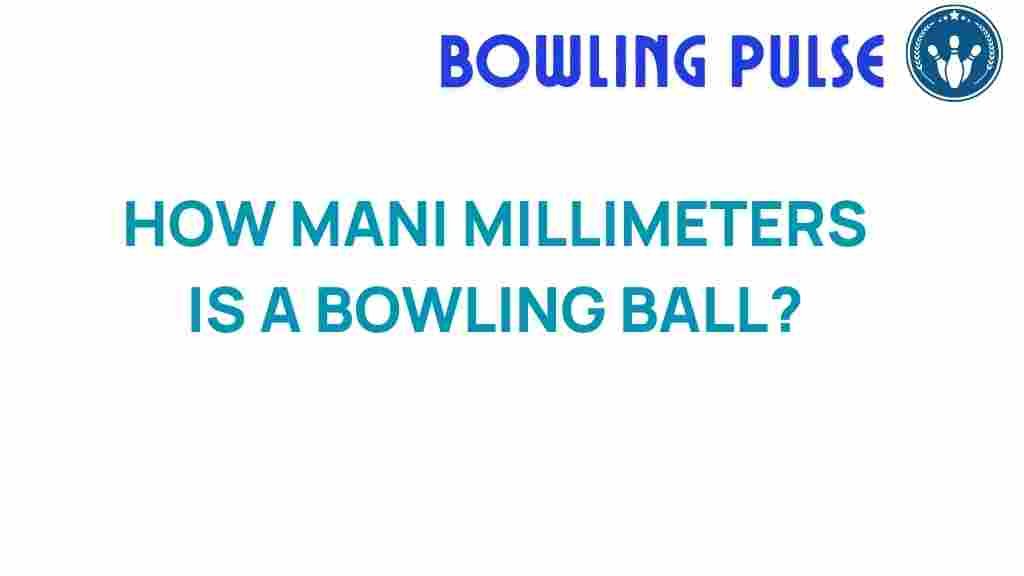Understanding Bowling Ball Size: The Surprising Science Behind How Many Millimeters a Bowling Ball Is
Bowling is a sport enjoyed by millions around the world, combining skill, precision, and a bit of luck. But did you know that the size of a bowling ball plays a significant role in your game? In this article, we will delve into the bowling ball size and its impact on performance, exploring the physics of bowling, the standards set for bowling equipment, and how these measurements have evolved over time.
The Importance of Bowling Ball Size
The bowling ball size is not arbitrary; it is governed by specific standards established by bowling governing bodies. This ensures consistency and fairness in the sport. A standard bowling ball has a diameter of 8.5 inches (approximately 216 mm) and typically weighs between 6 and 16 pounds (2.7 to 7.3 kg). Understanding these dimensions is crucial for players of all skill levels.
Bowling Physics: How Size Affects Performance
To comprehend the significance of bowling measurements, we must look at the physics involved in bowling. When you roll a bowling ball down the lane, several forces come into play:
- Gravity: The weight of the ball influences its speed and momentum.
- Friction: The interaction between the ball and the lane affects its movement and rotation.
- Spin: How you release the ball (hook or straight) alters its trajectory.
The ball dimensions directly impact how these forces affect the ball’s performance. A larger or heavier ball may maintain momentum better, while a smaller ball can be easier to control.
Bowling Equipment Standards
Bowling equipment, including balls, pins, and lanes, is regulated to ensure a level playing field. The bowling standards set by organizations such as the United States Bowling Congress (USBC) dictate the acceptable size, weight, and material of bowling balls. Here are some key points regarding these standards:
- **Diameter:** A regulation bowling ball must have a diameter of 8.5 inches (216 mm).
- **Weight:** The weight of the ball must be between 6 and 16 pounds.
- **Surface:** The material of the ball can vary, but it must be able to maintain its shape and performance over time.
These standards are crucial for maintaining the integrity of the sport and ensuring that players can compete fairly.
The Evolution of Bowling Ball Dimensions
The bowling history reveals a fascinating evolution of ball dimensions. In early bowling games, players used wooden balls, which varied greatly in size and weight. As the sport developed, manufacturers began to standardize measurements to enhance performance and consistency. The introduction of synthetic materials also revolutionized bowling equipment, allowing for greater versatility in ball design.
Choosing the Right Bowling Ball Size
Selecting the appropriate bowling ball size is essential for optimal performance. Here’s a step-by-step guide to help you find your perfect match:
- Assess Your Comfort: Start by trying out different weights. The right ball should feel comfortable when you lift and release it.
- Consider Your Skill Level: Beginners might benefit from lighter balls for better control, while advanced players may prefer heavier options for increased power.
- Consult a Professional: If you’re unsure, seek advice from a bowling coach or pro shop technician. They can provide insights based on your style and technique.
Finding the right bowling ball size can significantly impact your game, enhancing both your performance and enjoyment.
Troubleshooting Common Issues Related to Bowling Ball Size
Even with the right bowling measurements, you might encounter issues on the lanes. Here are some troubleshooting tips:
- Ball Won’t Hook: If your ball is not hooking as expected, it might be too heavy or the surface may need to be adjusted. Consider lighter options or consult a technician for resurfacing.
- Struggling with Control: If you find it challenging to control your shots, you may need to switch to a ball with a different grip or surface texture.
- Inconsistent Performance: If your ball performance varies significantly, double-check the weight and ensure it aligns with your throw style.
Addressing these issues early on can help maintain your confidence and enjoyment in the sport.
The Future of Bowling Ball Design
As technology advances, the design of bowling equipment continues to evolve. Innovations in materials and manufacturing processes are leading to new possibilities in ball dimensions. Some trends to watch include:
- Customizable Balls: Future designs may allow players to adjust weight and surface texture to suit their specific needs.
- Smart Technology: Integration of sensors to provide real-time feedback on performance and technique.
- Eco-friendly Materials: Growing awareness of environmental issues may lead to the use of sustainable materials in ball production.
Conclusion: Embracing the Science of Bowling
Understanding the bowling ball size and its implications in the sport is essential for every bowler, from beginners to professionals. By appreciating the bowling physics behind how a ball interacts with the lane, you can make more informed choices about your equipment.
As you evolve in your bowling journey, remember that the right bowling measurements can significantly enhance your game. Whether you’re playing for fun or competition, embracing the science behind bowling will help you to refine your skills and enjoy the sport even more.
For more information on bowling equipment and standards, visit the United States Bowling Congress. To learn more about the physics of sports, check out this comprehensive guide.
This article is in the category Equipment and created by BowlingPulse Team
